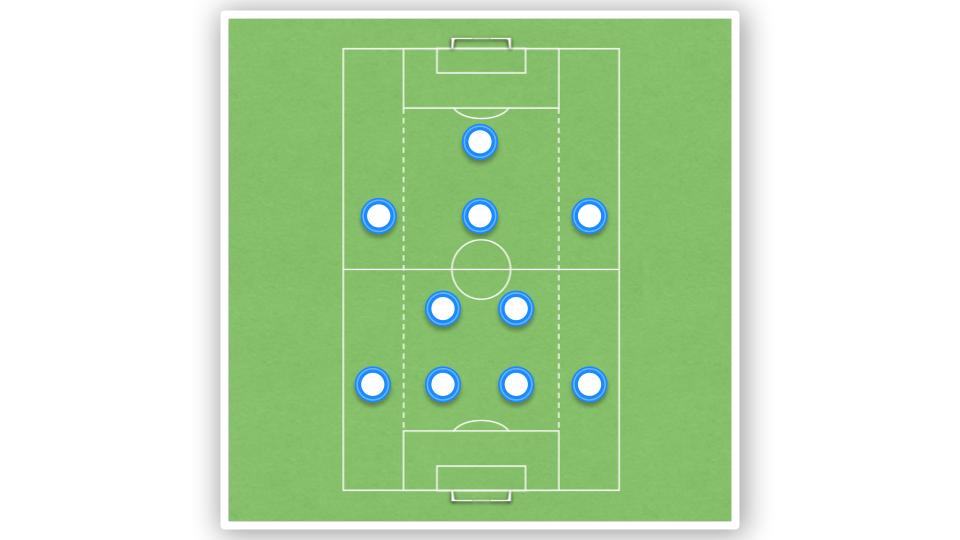Soccer’s Best Formation: A Comprehensive Guide
Soccer is a game that requires a perfect balance between attack and defense. Choosing the best formation for a team can make a significant difference in the outcome of a match. A formation is the way a team positions its players on the field. It determines the number of players in each position and the overall shape of the team.
There are numerous soccer formations to choose from, each with its own strengths and weaknesses. The best soccer formation depends on the team’s style of play, the players’ strengths and weaknesses, and the tactical approach of the coach. Some formations are designed to be more defensive, while others are more attacking. Some are suited for counter-attacking, while others are focused on ball possession.
In this article, we will explore the best soccer formations of 2023. We will discuss the pros and cons of each formation and provide guidance on how to choose the best formation for your team. Whether you are a coach looking to optimize your team’s performance or a player seeking to understand the game better, this article will provide you with valuable insights into the world of soccer formations.
Understanding Soccer Formations
What is a Formation?
In soccer, a formation refers to the way a team lines up its players on the field. It is a tactical decision made by the coach to optimize the team’s strengths and minimize its weaknesses. A formation is usually represented by a series of numbers that describe the number of players in each position. For example, a 4-4-2 formation means there are four defenders, four midfielders, and two forwards.
Importance of Formations
Formations are important because they dictate how a team plays both offensively and defensively. They can affect the team’s ability to control possession, create scoring opportunities, and defend against the opposition. A good formation can give a team an advantage over its opponents, while a poor formation can lead to a disadvantage.
Common Formations
There are many different formations that soccer teams can use, but some are more common than others. Here are a few of the most popular formations:
- 4-4-2: This is a classic formation that is often used by teams that want to play a balanced game. It has four defenders, four midfielders, and two forwards.
- 4-3-3: This formation is often used by teams that want to play an attacking style of soccer. It has four defenders, three midfielders, and three forwards.
- 3-5-2: This formation is often used by teams that want to control possession of the ball. It has three defenders, five midfielders, and two forwards.
- 4-2-3-1: This formation is often used by teams that want to play a more defensive style of soccer. It has four defenders, two defensive midfielders, three attacking midfielders, and one forward.
- 5-3-2: This formation is often used by teams that want to play a more defensive style of soccer. It has five defenders, three midfielders, and two forwards.
Each formation has its own strengths and weaknesses, and the coach must choose the formation that best suits the team’s style of play and the opposition they are facing.
Key Elements of a Soccer Formation
A soccer formation is a tactical strategy that coaches use to organize their team on the field. A good formation can help a team control the game, defend well, and create scoring opportunities. There are different types of formations, but each one has key elements that make it effective.
Defensive Line
The defensive line is made up of defenders, fullbacks, and central defenders, and its main goal is to prevent the other team from scoring. A good defensive line should be strong, organized, and able to work together to stop the other team’s attacks. The number of players in the defensive line can vary depending on the formation, but it is usually between three and five.
Midfielders
Midfielders are the players who control the game and connect the defense with the offense. They are responsible for creating scoring opportunities, maintaining possession, and defending. There are different types of midfielders, such as central midfielders, defensive midfielders, and attacking midfielders. A good midfield should be balanced, with players who can both attack and defend.
Forwards
Forwards, or strikers, are the players who are responsible for scoring goals. They are usually fast, skilled, and have good instincts in front of the goal. In some formations, there may be one or two forwards, while in others, there may be three or more.
Wingbacks
Wingbacks are specialized fullbacks who play on the wings of the field. They are responsible for both defending and attacking, and they need to be fast and have good crossing and passing skills. Wingbacks are often used in formations that require a lot of attacking from the wings.
Defensive Midfielder
The defensive midfielder is a specialized midfielder who is responsible for protecting the defensive line and breaking up the other team’s attacks. They are usually strong, physical players who are good at intercepting passes and tackling. The defensive midfielder is an important player in formations that prioritize defense.
In conclusion, a good soccer formation should have a strong defensive line, balanced midfield, skilled forwards, and specialized wingbacks and defensive midfielder (if necessary). The number of players in each position can vary depending on the formation, but each position is important for the success of the team.
Popular Soccer Formations
Soccer formations are the foundation of a team’s tactics and strategy. Choosing the right formation is crucial for success on the field. There are many different formations in soccer, each with its own strengths and weaknesses. In this section, we’ll explore some of the most popular soccer formations.
4-3-3 Formation
The 4-3-3 formation is one of the most popular formations in soccer. It is an attacking formation that focuses on creating opportunities through the wings. The formation consists of four defenders, three midfielders, and three forwards. The midfielders are responsible for controlling the game and distributing the ball to the forwards. The forwards are expected to be fast and agile, capable of creating scoring opportunities.
4-2-3-1 Formation

The 4-2-3-1 formation is a variation of the 4-3-3 formation. It is a balanced formation that allows for both attacking and defensive play. The formation consists of four defenders, two defensive midfielders, three attacking midfielders, and one forward. The attacking midfielders are responsible for creating scoring opportunities for the lone forward.
4-4-2 Formation

The 4-4-2 formation is a classic formation that has been used for decades. It is a balanced formation that focuses on both attacking and defensive play. The formation consists of four defenders, four midfielders, and two forwards. The midfielders are responsible for controlling the game and distributing the ball to the forwards.
5-3-2 Formation
The 5-3-2 formation is a defensive formation that focuses on preventing the opposition from scoring. The formation consists of five defenders, three midfielders, and two forwards. The defenders are responsible for preventing the opposition from scoring, while the midfielders and forwards are responsible for creating scoring opportunities.
3-5-2 Formation

The 3-5-2 formation is an attacking formation that focuses on creating scoring opportunities through the middle of the field. The formation consists of three defenders, five midfielders, and two forwards. The midfielders are responsible for controlling the game and distributing the ball to the forwards. The forwards are expected to be fast and agile, capable of creating scoring opportunities.
3-4-3 Formation

The 3-4-3 formation is an attacking formation that focuses on creating scoring opportunities through the wings. The formation consists of three defenders, four midfielders, and three forwards. The midfielders are responsible for controlling the game and distributing the ball to the forwards. The forwards are expected to be fast and agile, capable of creating scoring opportunities.
4-5-1 Formation
The 4-5-1 formation is a defensive formation that focuses on preventing the opposition from scoring. The formation consists of four defenders, five midfielders, and one forward. The midfielders are responsible for controlling the game and distributing the ball to the lone forward.
5-4-1 Formation
The 5-4-1 formation is an extremely defensive formation that focuses on preventing the opposition from scoring. The formation consists of five defenders, four midfielders, and one forward. The midfielders are responsible for controlling the game and distributing the ball to the lone forward.
4-1-4-1 Formation

The 4-1-4-1 formation is a balanced formation that focuses on both attacking and defensive play. The formation consists of four defenders, one defensive midfielder, four attacking midfielders, and one forward. The attacking midfielders are responsible for creating scoring opportunities for the lone forward.
4-4-2 Diamond Formation

The 4-4-2 diamond formation is a variation of the 4-4-2 formation. It is an attacking formation that focuses on creating scoring opportunities through the middle of the field. The formation consists of four defenders, one defensive midfielder, two central midfielders, one attacking midfielder, and two forwards. The attacking midfielder is responsible for creating scoring opportunities for the forwards.
In conclusion, the choice of formation depends on the team’s strengths and weaknesses, the opposition, and the game situation. Each formation has its own strengths and weaknesses, and it is up to the coach to choose the right formation based on the team’s needs.
Strengths and Weaknesses of Popular Formations
When it comes to soccer formations, each one has its own set of strengths and weaknesses. By understanding these, coaches can choose the best formation to suit their team’s style of play and opponent. Here are the strengths and weaknesses of some of the most popular soccer formations:
4-3-3 Formation
The 4-3-3 formation is a popular choice for teams who prioritize attacking threat and possession. With three forwards, the team has a lot of offensive firepower and can create many scoring opportunities. However, the formation can leave the team vulnerable defensively, especially if the midfielders are not disciplined enough to track back and defend.
4-2-3-1 Formation
The 4-2-3-1 formation is another popular choice for teams who prioritize possession and attacking threat. The two defensive midfielders provide defensive stability, while the attacking midfielder and wingers create scoring opportunities for the lone striker. However, the formation can leave the team vulnerable on the wings if the fullbacks push too far forward.
4-4-2 Formation
The 4-4-2 formation is a classic formation that provides a good balance between defense and offense. The two strikers provide attacking threat, while the four midfielders provide defensive cover and possession. However, the formation can leave the team vulnerable in the middle of the park if the opposition has a strong central midfield.
5-3-2 Formation
The 5-3-2 formation is a defensive-minded formation that prioritizes defensive stability and counter-attacking. With five defenders, the team is difficult to break down, while the three midfielders provide a solid base for counter-attacks. However, the formation can leave the team lacking attacking threat, especially if the wing-backs are not able to provide enough width.
3-5-2 Formation
The 3-5-2 formation is a versatile formation that can be used both defensively and offensively. With three center-backs, the team has a solid defensive base, while the five midfielders provide possession and attacking threat. However, the formation can leave the team vulnerable on the wings if the wing-backs are not able to provide enough defensive cover.
3-4-3 Formation
The 3-4-3 formation is an attacking-minded formation that prioritizes attacking threat and possession. With three forwards and four midfielders, the team has a lot of offensive firepower and can create many scoring opportunities. However, the formation can leave the team vulnerable defensively, especially if the opposition has a strong central midfield.
4-5-1 Formation
The 4-5-1 formation is a defensive-minded formation that prioritizes defensive stability and possession. With five midfielders, the team is difficult to break down, while the lone striker provides a target for counter-attacks. However, the formation can leave the team lacking attacking threat, especially if the midfielders are not able to provide enough support to the lone striker.
5-4-1 Formation
The 5-4-1 formation is an ultra-defensive formation that prioritizes defensive stability above all else. With five defenders and four midfielders, the team is difficult to break down, but lacks attacking threat. However, the formation can be effective against stronger opponents, especially if the team is able to score on the counter-attack.
4-1-4-1 Formation
The 4-1-4-1 formation is a defensive-minded formation that prioritizes defensive stability and possession. With one defensive midfielder and four midfielders, the team is difficult to break down, while the lone striker provides a target for counter-attacks. However, the formation can leave the team lacking attacking threat, especially if the midfielders are not able to provide enough support to the lone striker.
4-4-2 Diamond Formation
The 4-4-2 diamond formation is an attacking-minded formation that prioritizes possession and attacking threat. With four midfielders in a diamond shape, the team has a lot of offensive firepower and can create many scoring opportunities. However, the formation can leave the team vulnerable defensively, especially if the opposition has strong wingers.
Overall, each formation has its own set of strengths and weaknesses. Coaches should choose the formation that best suits their team’s style of play and opponent, and make adjustments as necessary throughout the game.
Role of the Coach in Choosing the Right Formation
The coach plays a crucial role in determining the formation that a team will use in a game. The coach must analyze the strengths and weaknesses of the team, assess the opponent’s formation, and adapt to game situations to choose the right formation.
Factors Influencing Formation Choice
The coach must consider several factors when choosing the right formation for a team. These factors include the team’s strengths and weaknesses, the opponent’s formation, the game situation, and the coach’s tactical preferences. The coach must also consider the players’ positions, skills, and abilities when selecting a formation.
To help the coach choose the right formation, they can use a variety of tools such as video analysis, scouting reports, and statistical data. These tools can provide valuable insights into the team’s performance and help the coach make informed decisions about the formation.
Adapting to Opponents
The coach must also be flexible and adaptable when choosing the right formation. They must be able to adjust the formation during the game to counter the opponent’s tactics and exploit their weaknesses. For example, if the opponent is playing with a high defensive line, the coach may choose a formation with fast attacking players to exploit the space behind the defense.
To be successful in adapting to opponents, the coach must have a deep understanding of the game and be able to read the game as it unfolds. They must also be able to communicate effectively with the players and make quick decisions based on the game situation.
In summary, the coach plays a critical role in choosing the right formation for a team. They must consider several factors when selecting a formation and be flexible and adaptable during the game to counter the opponent’s tactics. With the right tactics and strategy, a coach can help their team achieve success on the field.
Player Roles in Different Formations
When it comes to soccer formations, each player has a specific role to play. The formation dictates the number of players in each position and the overall strategy of the team. In this section, we will discuss the different player roles in various formations.
Defenders
Defenders are responsible for protecting the team’s goal and preventing the opposing team from scoring. In most formations, there are four defenders, two center backs, and two fullbacks. The center backs are the primary defenders who stay close to the goal, while the fullbacks play a more attacking role, providing support to the midfield.
In some formations, such as the 3-5-2, there are three center backs and two wingbacks. The wingbacks play a similar role to the fullbacks, providing width to the team’s attack.
Midfielders
Midfielders are the link between the defense and the attack. They are responsible for controlling the game, creating chances, and defending. The number of midfielders varies depending on the formation, but most formations have at least three midfielders.
In some formations, such as the 4-4-2, there are two central midfielders, one attacking midfielder, and one wide midfielder. In other formations, such as the 4-2-3-1, there are two holding midfielders, one central attacking midfielder, and two wide midfielders.
Forwards
Forwards are responsible for scoring goals and creating chances. The number of forwards in a formation varies, but most formations have at least one striker.
In some formations, such as the 4-4-2, there are two strikers who play together as a front two. In other formations, such as the 4-2-3-1, there is one lone striker who plays up top, supported by attacking midfielders and wide forwards.
Conclusion
In summary, each player has a specific role to play in a soccer formation. Defenders protect the goal, midfielders control the game, and forwards score goals. The number of players in each position and the overall strategy of the team vary depending on the formation.
Famous Soccer Formations and Their Impact
Total Football
Total Football is a tactical system that prioritizes flexibility and fluidity on the pitch. It was first developed by the Netherlands in the 1970s, and it has since become a hallmark of Dutch football. The system is built around the idea that every player should be able to play any position on the field, allowing for seamless transitions between defense, midfield, and attack. Total Football is known for its attacking football, passing options, and defensive stability.
Barcelona’s Tiki-Taka
Tiki-Taka is a style of play that prioritizes possession and patient, organized build-up play. It was popularized by Barcelona under the leadership of Pep Guardiola and Xavi in the late 2000s and early 2010s. The system is built around quick, short passes and constant movement, which allows Barcelona to dominate possession and control the tempo of the game. Tiki-Taka is known for its attacking football, passing options, and ability to wear down opponents over the course of a match.
Real Madrid’s Counterattack
Real Madrid’s counterattack is a tactical system that prioritizes quick transitions from defense to attack. It was popularized by Jose Mourinho during his time as Real Madrid’s manager in the early 2010s. The system is built around a solid defensive foundation that allows Real Madrid to absorb pressure and quickly launch counterattacks when the opportunity arises. Real Madrid’s counterattack is known for its speed, directness, and ability to catch opponents off guard.
Liverpool’s High Pressing
Liverpool’s high pressing is a tactical system that prioritizes pressing high up the pitch to win the ball back quickly. It was popularized by Jurgen Klopp during his time as Liverpool’s manager in the mid-2010s. The system is built around a high-energy, high-intensity style of play that puts pressure on opponents and forces them into mistakes. Liverpool’s high pressing is known for its intensity, organization, and ability to create scoring opportunities through turnovers.
Netherlands’ 3-4-3 Formation
The Netherlands’ 3-4-3 formation is a tactical system that prioritizes attacking play and flexibility. It was used by the Netherlands during the 2014 World Cup under the leadership of Louis van Gaal. The system is built around a front three that is supported by a midfield four and a back three. This allows for a high degree of attacking freedom while still maintaining defensive stability. The Netherlands’ 3-4-3 formation is known for its attacking football, flexibility, and ability to create scoring opportunities through overlapping runs.
Spain’s Possession Game
Spain’s possession game is a tactical system that prioritizes dominating possession and controlling the tempo of the game. It was popularized by Spain under the leadership of Antonio Conte and Xavi in the mid-2010s. The system is built around a patient, organized style of play that focuses on maintaining possession and creating scoring opportunities through quick, short passes. Spain’s possession game is known for its passing options, defensive stability, and ability to wear down opponents over the course of a match.
In conclusion, each of these famous soccer formations has had a significant impact on the game of soccer. Whether it’s Total Football’s flexibility, Barcelona’s Tiki-Taka’s possession-based style, Real Madrid’s counterattack, Liverpool’s high pressing, Netherlands’ 3-4-3 formation, or Spain’s possession game, each system has its own strengths and weaknesses. By studying these formations and their impact on the game, coaches and players can gain a deeper understanding of the tactical nuances of soccer and improve their own performance on the pitch.
Conclusion
Choosing the best soccer formation for a team can be a daunting task. It requires analyzing the team’s strengths and weaknesses, as well as considering the opponent’s style of play. The search results provide a variety of options to choose from, including the 3-4-3, 4-1-4-1, 4-5-1, 4-3-3, 4-2-3-1, and 4-4-2 formations.
One important factor to consider is the team’s style of play. For example, the 3-4-3 formation is considered the best attacking formation, while the 4-1-4-1 is the best defending formation. The 4-5-1 is the best counter-attacking formation, while the 4-3-3 is the best pressing formation. The 4-2-3-1 is the best formation for keeping possession, while the 4-4-2 is the best formation for a weak team.
Another important factor to consider is the players’ positions and roles within the formation. Each player must understand their responsibilities and work together as a cohesive unit. For example, in the 4-2-3-1 formation, the two central midfielders must work together to control the midfield, while the wingers must provide width and support the lone striker.
Ultimately, the best soccer formation for a team depends on a variety of factors, including the team’s style of play, the opponent’s style of play, and the players’ positions and roles within the formation. Coaches must carefully consider these factors and choose the formation that best suits their team’s needs.







